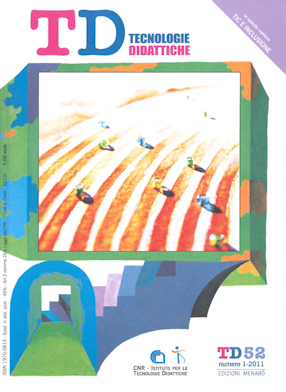Educational methodologies and ict to help learning in motor-impaired children
Main Article Content
Abstract
Article Details
Section
Authors who publish with this journal agree to the following terms:
- Authors retain copyright and grant the journal right of first publication with the work simultaneously licensed under a Creative Commons CC BY 4.0 Attribution 4.0 International License.
- Authors are able to enter into separate, additional contractual arrangements for the non-exclusive distribution of the journal's published version of the work (e.g., post it to an institutional repository or publish it in a book), with an acknowledgement of its initial publication in this journal.
- Authors are permitted and encouraged to post their work online (e.g., in institutional repositories or on their website) prior to and during the submission process, as it can lead to productive exchanges, as well as earlier and greater citation of published work (See The Effect of Open Access)
References
Baldazzi et al. (2004). Le competenze dei bambini di prima elementare: un approccio all’aritmetica. La matematica e la sua didattica, 18(1), pp. 47-95.
Aglì F., Martini A. (1995). Rappresentazione e notazione della quantità in età prescolare. Età evolutiva. 51, pp. 30-43.
Benelli B., D’Odorico L., Lavorato M.C., Simion F. (1977). Formation and extension of the concept in a prelinguistic child. Italian Journal of Psychology, 3, pp. 429-448.
Benelli B., D’Odorico L., Lavorato M.C., Simion F. (1980). Forme di conoscenza prelinguistica. Firenze: Giunti. Boero P. (1989). Semantic fields suggested by history: their function in the acquisition of mathematical concepts. Zentralblatt für Didaktik der Mathematik, 20, pp. 128-133.
Boero P. (1992). The crucial role of semantic fields in the development of problem solving skills. In J.P. Pedro Ponte, J.F. Matos, J.M. Matos, D. Fernandes. (eds.). Mathematical Problem Solving and New Information Technologies. Berlin, Germany: Springer - Verlag, pp. 77-91.
Boero P. (1994). Experience fields as a tool to plan mathematics teaching from 6 to 11. In. L. Bazzini, H.G. Steiner (eds.). Proceedings of the II Italian - German Bilateral Symposium on Didactics of Mathematics, 39, pp. 45-62.
Boero P., Rondini A. (eds.) (1996). Bambini, maestri, realtà. Rapporto tecnico, 1(I). Genova: Dipartimento di Matematica, Università di Genova.
Bottino R.M., Chiappini G. (2001). Il ruolo delle nuove tecnologie per superare le difficoltà di apprendimento in aritmetica. In E. Livorni, G. Meloni , A. Pesci (eds.). Le difficoltà in Matematica: da problema di pochi a risorsa per tutti, Atti del Convegno Nazionale Matematica e difficoltà, (Castel S. Pietro Terme, febbraio 2001). Bologna:Pitagora Editrice, pp.3-13.
Dapueto C., Parenti L. (1999). Contributions and Obstacles of Contexts in the Development of Mathematical Knowledge. Educational Studies in Mathematics, 39(1), pp. 1-21.
Dehaene S. (1999). The number sense: how the mind creates mathematics. UK: Oxford University Press.
Galimberti U. (1999). Dizionario di psicologia. Torino: UTET.
Girelli L., Lucangeli D., Butterworth B. (2000). The development of automaticity in accessing number magnitude. Journal of Experimental Child Psychology, 76(2), pp. 104-122.
Hughes S. (1982). Another look at task analysis. Journal of Learning Disabilities, 15(5), pp. 273-275.
Lucangeli D. (2001). Lo sviluppo della conoscenza numerica: le abilità cognitive. In B. D’Amore (ed.). Didattica della matematica e rinnovamento curricolare. Bologna: Pitagora Editrice, pp. 97-106.
Robutti O. (2000). Parliamo di riforma: nuclei fondanti e competenze in matematica. Progetto Alice, 1(3), pp. 513-529.
Scali E. (1994). Costruzione dei significati del numero naturale in prima elementare: il ruolo dei campi di esperienza e la funzione mediatrice dell’insegnante. In M. Basso et. al. (eds.). Atti del I Internuclei Scuola dell’Obbligo, (Salsomaggiore Terme, 14-16 aprile 1994). Parma: Centro grafico Università degli Studi di Parma.
Stella G., Zanotti S. (1993). Selective Neuropsychological Problems of Learning in Disability. In M. Bottos, D. Scrutton, A. Ferrari & B.G.R. Neville (eds.). In The Restored infant. Proceeding of the fourth EACD Meeting. Pozzolatico, Firenze: Fisoray Edizioni.
Stella G., Biolcati C. (2003). La valutazione neuropsicologica in bambini con danno neuromotorio. In M. Bottos (ed.). Paralisi Cerebrale Infantile. Dalla guarigione all’autonomia. Diagnosi e proposte riabilitative. Padova: Piccin Editore, pp. 53-61.
Sullivan H.S. (1953). The interpersonal Theory of Psychiatry. New York: Norton. Trad It. E.D. Mezzacapa (1977). Teoria interpersonale della Psichiatria. Milano: Feltrinelli, pp. 443.
Teruggi L.A. (2001). Scritture numeriche nella scuola dell’infanzia. In B. D’Amore (ed.). Didattica della matematica e rinnovamento curricolare, pp. 119-130.

